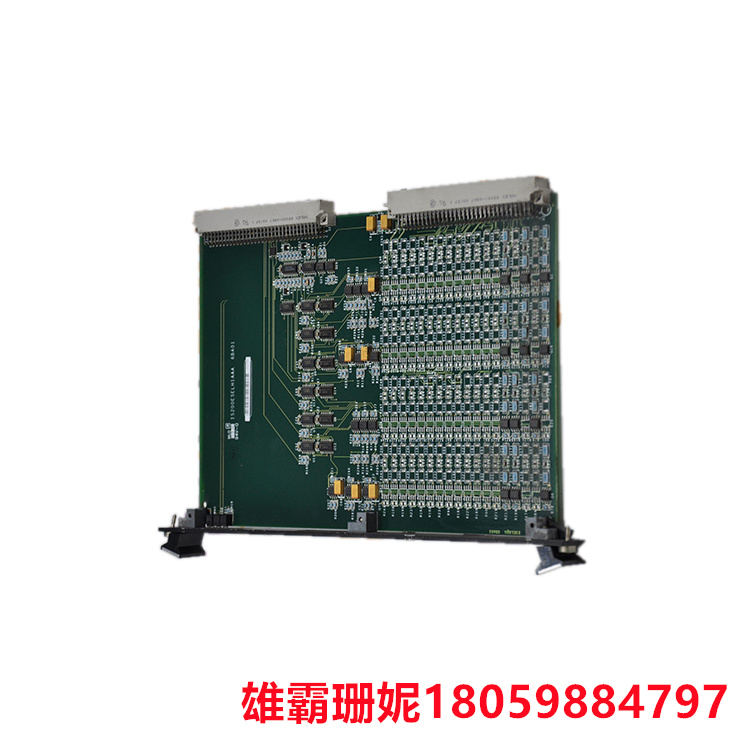
型号IS200ESELH1A连接到EMIO板,从而接收六个逻辑电平门信号。该模型是IS200ESELH1,只包含一个桥接驱动器。如果在电源转换柜中有冗余控制,则需要使用两块ESEL板。
IS200ESELH1A是一款励磁器选择板,该板曾由通用电气公司EX2100系列生产。当这个板被使用时,它将从它所连接的EMIO接收六个逻辑电平脉冲信号。接收到的信号将被发送到一组六电缆,然后信号被分配到EGPA板。如果在使用此板时使用冗余控件,则必须使用两个IS200ESELH1A模型。
ESEL1、ESEL2和ESEL3三个不同的ESEL板组,根据组的不同,会有一定数量的桥接驱动,因为这个型号是ESEL1型号,只需要一个桥接驱动。ESEL模型是EX2100系统中操作其他板的组成部分,如上所述,ESEL模型向EGPA板发送门脉冲信号,一旦信号被EGPA板接收,信号将用于控制可控硅栅极发射。
IS200ESELH1A 励磁调节器的常见故障有以下几种:
- 调节器不工作:调节器无法输出励磁电流,导致电机无法正常运行。
- 励磁电流不稳定:励磁电流波动较大,导致电机运行不稳定。
- 调节器过热:调节器内部元件过热,导致调节器失效。
- 励磁电流过大:励磁电流超过设定值,导致电机过励磁。
- 励磁电流过小:励磁电流小于设定值,导致电机欠励磁。
- 励磁电压不稳定:励磁电压波动较大,导致电机运行不稳定。
- 调节器参数错误:调节器参数设置错误,导致调节器无法正常工作。
以上是励磁调节器的常见故障,具体的故障原因可能因励磁调节器的型号和制造商而有所不同。建议参考励磁调节器的用户手册或咨询制造商以获取更详细和准确的故障排除指导。

The model IS200ESELH1A is connected to the EMIO board and thus receives six logic level gate signals. The model is IS200ESELH1 and contains only one bridge driver. If there are redundant controls in the power conversion cabinet, two ESEL boards will need to be used.
The IS200ESELH1A is an exciter selector board formerly produced by General Electric's EX2100 series. When the board is in use, it will receive six logic level pulses from the EMIO it is connected to. The received signal is sent to a set of six cables, and the signal is then distributed to the EGPA board. If you use redundant controls when using this board, you must use two IS200ESELH1A models.
There are three different ESEL board groups, ESEL1, ESEL2, and ESEL3, and depending on the group, there will be a certain number of bridge drivers, because this model is an ESEL1 model, and only one bridge driver is required. The ESEL model is an integral part of the EX2100 system that operates the other boards, as mentioned above, the ESEL model sends a gate pulse signal to the EGPA board, and once the signal is received by the EGPA board, the signal is used to control the thyristor gate emission.
The common faults of IS200ESELH1A excitation regulator are as follows:
- The regulator does not work: The regulator cannot output the excitation current, resulting in the motor cannot operate normally.
- Unstable excitation current: the excitation current fluctuates greatly, resulting in unstable motor operation.
- Regulator overheat: The internal components of the regulator overheat, resulting in the failure of the regulator.
- Excessive excitation current: The excitation current exceeds the set value, resulting in over-excitation of the motor.
- Excitation current is too small: the excitation current is less than the set value, resulting in underexcitation of the motor.
- Unstable excitation voltage: The excitation voltage fluctuates greatly, resulting in unstable motor operation.
- Regulator parameter error: The regulator parameter Settings are incorrect, causing the regulator to fail to work properly.
The above are common failures of excitation regulators, and the specific cause of the failure may vary depending on the model and manufacturer of the excitation regulator. It is recommended to refer to the excitation regulator's user manual or consult the manufacturer for more detailed and accurate troubleshooting guidance.

| GE | IS210BPPBH2BMD | GE | Hydran M2 |
| GE | IS210SAMBH2AA | A-B | 2098-DSD-020X/C |
| GE | IS210WSVOH1AE | BENTLY | 128229-01 |
| GE | IS215ACLEH1BB | BENTLY | 128229-01 |
| GE | IS215UCVEH2AB | BLACK BOX | ACR1000A-R2 |
| GE | IS215UCVEH2AE | TRICONEX | 3504E |
| GE | IS215UCVEM10A | ABB | 3BDH000741R1 |
| GE | IS215VPROH1BD | HONEYWELL | TK-CCR014 |
| GE | IS220PAICH1A | WOODHEAD | DRL-DPM-BKF |
Copyright © 2022-2024 厦门雄霸电子商务有限公司 版权所有 备案号:闽ICP备14012685号-33